Gall & Gall
Has an outstanding range of Dutch jenevers (gins) and flavoured spirits as well as a good selection of imported wines. Part of a popular chain.
The narrow slice of land sandwiched between the curve of the River Amstel, Oudeschans and the Nieuwe Herengracht was the home of Amsterdam’s Jews from the sixteenth century up until World War II. By the 1920s, this Old Jewish Quarter, or the Jodenhoek (“Jews’ Corner”), was crowded with tenement buildings and smoking factories, its main streets holding scores of open-air stalls selling everything from pickled herrings to pots and pans. The war put paid to all this. In 1945 it lay derelict, and neither has postwar redevelopment treated it kindly; new building has robbed the district of much of its character. But persevere: among the cars and concrete around Waterlooplein and Mr Visserplein are several moving reminders of the Jewish community that perished in the war, while the neighbouring residential area of Plantagebuurt is home to the Artis Zoo and the excellent Verzetsmuseum (Dutch Resistance Museum). From here it’s a short hop north to Oosterdok, where pride of place goes to the Nederlands –Scheepvaartmuseum (Maritime Museum), though this is currently closed for redevelopment.
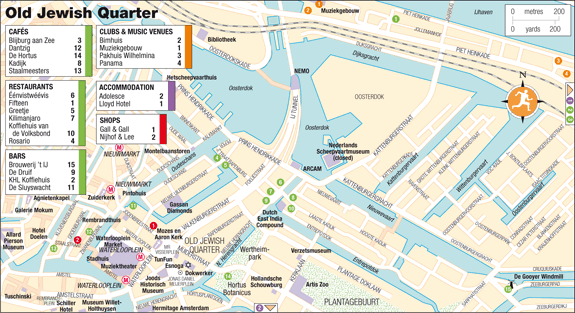
St Antoniesbreestraat runs into Jodenbreestraat, the “Broad Street of the Jews”, which was once the main centre of Jewish activity. This ancient thoroughfare is short on charm, but it is home to the Rembrandthuis, whose intricate facade is decorated with pretty wooden shutters. Rembrandt bought this house at the height of his fame and popularity, living here for over twenty years and spending a fortune on furnishings – an expense that ultimately contributed to his bankruptcy. An inventory made at the time details the huge collection of paintings, sculptures and art treasures he’d amassed, almost all of which was auctioned off after he was declared insolvent and forced to move to a more modest house in the Jordaan in 1658.
The city council bought the Jodenbreestraat house in 1907 and has revamped the premises on several occasions, most recently in 1999. A visit begins in the modern building next door, but you’re soon into the string of period rooms that have been returned to something like their appearance when Rembrandt lived here, with the inventory as a guide. The period furniture is enjoyable enough, especially the box-beds, and the great man’s studio is surprisingly large and well-lit, but there are no Rembrandt paintings on display except when there are special exhibitions (for which expect to pay extra). However, the museum possesses an extensive collection of Rembrandt’s etchings and prints as well as several of the original copper plates on which he worked, and these are on display when temporary exhibitions allow. To see more of Rembrandt’s paintings, head for the Rijksmuseum.
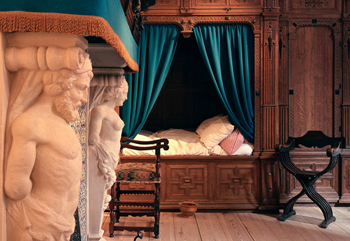
Nieuwe Uilenburgerstraat 173
![]() 020/622 5333
020/622 5333
Frequent 1hr guided tours daily 9am–5pm
Free
no advance booking required
Gassan Diamonds occupies a large and imposing brick building dating from 1897. Before World War II, many local Jews worked as diamond cutters and polishers, but there’s little sign of the industry hereabouts today, this factory being the main exception. Tours include a visit to the cutting and polishing areas, as well a gambol round Gassan’s diamond jewellery showroom.
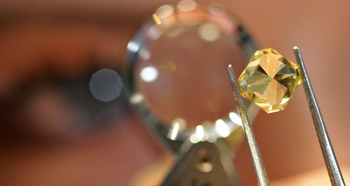
Jodenbreestraat runs parallel to the Stadhuis en Muziektheater, a sprawling and distinctly underwhelming modern complex dating from the 1980s and incorporating the city hall and a large auditorium. The Muziektheater offers a varied programme of theatre, dance and ballet as well as opera from the country’s first-rate Netherlands Opera (De Nederlandse Opera www.dno.nl), but tickets go very quickly. One of the city’s abiding ironies is that the title of the protest campaign aiming to prevent the development in the 1980s – “Stopera” – has passed into common usage to describe the finished item. Inside, amid all the architectural mediocrity, there are a couple of minor attractions, beginning with the glass columns in the public passageway towards the rear of the complex. These give a salutary lesson on the fragility of the Netherlands: two columns contain water indicating the sea levels in the Dutch towns of Vlissingen and IJmuiden (below knee height), while another records the levels experienced during the 1953 flood disaster (way above head height). At their base, a concrete pile shows what is known as “Normal Amsterdam Level” (NAP), originally calculated in 1684 as the average water level in the river IJ and still the basis for measuring altitude above sea level across Europe.
The indeterminate modernity of the Stadhuis complex dominates Waterlooplein, a rectangular parcel of land that was originally swampy marsh. This was the site of the first Jewish Quarter, but by the late nineteenth century it had become an insanitary slum. The slums were cleared in the 1880s and thereafter the open spaces of the Waterlooplein hosted the largest and liveliest market in the city, the place where Jews and Gentiles met to trade. In the war, the Germans used the square to round up their victims, but despite these ugly connotations the Waterlooplein was revived in the 1950s as the site of the city’s main flea market (Mon–Sat 9am–5pm) and remains so to this day. It’s nowhere near as large as it once was, but nonetheless it’s still the final resting place of many a pair of yellow corduroy flares and has some wonderful antique and junk stalls to root through – and secondhand vinyl too. If you’re after a bargain or two, head there early, as it’s very popular with tourists.
Nearby, at the very tip of Waterlooplein, where the River Amstel meets the Zwanenburgwal canal, there is a sombre memorial – a black stone tribute to the dead of the Jewish resistance. The inscription from Jeremiah translates, “If my eyes were a well of tears, I would cry day and night for the fallen fighters of my beloved people.”
Just behind the Muziekt-heater, on the corner of Mr Visserplein, is the Mozes en Aaron Kerk, a rather glum Neoclassical structure built on the site of a clandestine Catholic church in the 1840s. The square itself, a busy junction for traffic speeding towards the IJ tunnel, takes its name from Mr Visser, President of the Supreme Court of the Netherlands in 1939. He was dismissed the following year when the Germans occupied the country, and became an active member of the Jewish resistance, working for the illegal underground newspaper Het Parool (“The Password”) and refusing to wear the yellow Star of David. He died in 1942, a few days after publicly – and famously – denouncing all forms of collaboration.
Mr Visserplein
April–Oct Sun–Fri 10am–4pm; Nov–March Sun–Thurs 10am–4pm & Fri 10am–2pm
closed Yom Kippur
€6.50
The brown and bulky brickwork of the Esnoga or Portuguese synagogue was completed in 1675 for the city’s Sephardic community. One of Amsterdam’s most imposing buildings, it has been barely altered since its construction, its lofty interior following the Sephardic tradition in having the Hechal (the Ark of the Covenant) and tebah (from where services are led) at opposite ends. Also traditional is the seating, with two sets of wooden benches (for the men) facing each other across the central aisle – the women have separate galleries up above. A set of superb brass chandeliers holds the candles that remain the only source of artificial light. When it was completed, the synagogue was one of the largest in the world, its congregation almost certainly the richest; today, the Sephardic community has dwindled to just 250 families, most of whom live outside the city centre. In one of the outhouses, a video sheds light on the history of the synagogue and Amsterdam’s Sephardim. The mystery is why the Nazis left the building alone – no one knows for sure, but it seems likely that they intended to turn it into a museum once all the Jews had been polished off.
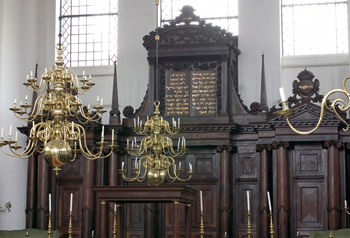
This large indoor playground near the Portuguese synagogue for children aged 1–12, has lots of equipment to clamber into, under and over, and a host of activities and workshops including football, gymnastics, films and trampolining. Children must be accompanied by an adult, and there’s a café to sit in if you feel you’ve already been in one ball park too many.
Jonas Daniel Meijerplein was where, in February 1941, around 400 Jewish men were forcibly loaded up on trucks and taken to their deaths at Mauthausen concentration camp, in reprisal for the killing of a Dutch Nazi during a street fight. The arrests sparked off the February Strike, a general strike in protest against the Germans’ treatment of the Jews. It was organized by the outlawed Communist Party and spearheaded by Amsterdam’s transport workers and dockers – a rare demonstration of solidarity with the Jews, whose fate was usually accepted without visible protest in all of occupied Europe. The strike was quickly suppressed, but is still commemorated by an annual wreath-laying ceremony on February 25, as well as by Mari Andriessen’s statue The Dokwerker (Dockworker) standing on the square.
The Joods Historisch Museum – Jewish Historical Museum – is cleverly shoehorned into four adjacent Ashkenazi synagogues that date back to the late seventeenth century. For many years after the war these buildings lay abandoned, but they were refurbished – and connected by walkways – in the 1980s to accommodate a Jewish resource centre and exhibition area. Renovations have given the museum more space to host some splendid temporary exhibitions in the New Synagogue, as well as an overview of the more recent history of Jews in the Netherlands divided into three periods – pre-, during and postwar. The highlight of a visit is the display on Jewish religion and traditions until 1900, exhibited in the main body of the handsome Grote Synagogue, which includes a collection of religious silverware as well as some paintings, plus all manner of antique artefacts illustrating religious practices. The third synagogue open to the public, Obbene Sjoel, has been turned into a multi-level children’s museum giving them an insight in the Jewish way of living.

In 2004, the renowned Hermitage museum in St Petersburg opened its first foreign branch here in Amsterdam, a result of the close cooperation between the museum and Amsterdam’s Nieuwe Kerk. With some three million items, the Hermitage is Russia’s leading art museum, possessing an extensive collection of medieval and early modern paintings as well as oriental art and Post-Impressionist work. Initially, small parts of the Hermitage collection were shown in Amsterdam during temporary exhibitions and these proved so popular that they inspired a much larger project: the Amstelhof, a large former nursing home built between 1681 and 1683, and that had lain empty for many years, was redeveloped at great cost to house material loaned by the Hermitage. The Amstelhof now provides the Hermitage with over 4000 square metres of exhibition space, quite enough to house a string of prestigious temporary displays.
Developed in the middle of the nineteenth century, the Plantagebuurt, with its comfortable streets spreading to either side of the Plantage Middenlaan boulevard, was built as part of a concerted attempt to provide good-quality housing for the city’s expanding middle classes. Although it was never as fashionable as the older residential parts of the Grachtengordel, the new district did contain elegant villas and spacious terraces, making it a first suburban port of call for many aspiring Jews. Nowadays, the Plantagebuurt is still one of the more prosperous parts of the city, in a modest sort of way, and boasts two especially enjoyable attractions – the Hortus Botanicus botanical gardens and the Verzetsmuseum (Dutch Resistance Museum).
Plantage Middenlaan 2a
![]() 020/625 9021
020/625 9021
Mon–Fri 9am–5pm, Sat & Sun 10am–5pm
closes 4pm in Dec & Jan, open until 7pm in July & Aug
€7.50
Amsterdam’s lush Hortus Botanicus were founded in 1682 as medicinal gardens for the use of the city’s physicians and apothecaries. Thereafter, many of the city’s merchants made a point of bringing back exotic species from the East, the result being the 6000-odd plant species exhibited today. The gardens are divided into several distinct sections, each clearly labelled and its location pinpointed by a map available at the entrance kiosk.
Most of the outdoor sections are covered by plants, trees and shrubs from the temperate and Arctic zones. There’s also a three-climates glasshouse, where the plants are arranged according to their geographical origins, a capacious palm house, an orchid nursery and a butterfly house. It’s all very low-key – and none the worse for that – and the gardens make a relaxing break on any tour of central Amsterdam, especially as the café, in the old orangery, serves up tasty sandwiches, coffee and cakes (see Cafés).
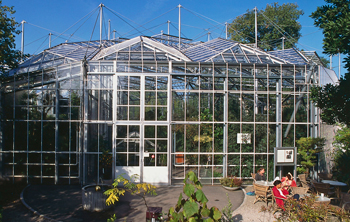
The pocket-sized Wertheimpark, across the road from the Hortus Botanicus, is home to the Auschwitz Monument, a simple affair with symbolically broken mirrors and an inscription that reads Nooit meer Auschwitz (“Auschwitz – Never Again”). It was designed by the late Dutch writer Jan Wolkers.
Another sad relic of the war, De Hollandsche Schouwburg was once a thriving Jewish theatre, but the Nazis turned it into the main assembly point for Amsterdam Jews prior to their deportation. Inside, there was no daylight and families were interned in conditions that foreshadowed those of the camps they would soon be taken to. The building has been refurbished to house a small exhibition on the plight of the city’s Jews, but the old auditorium out at the back has been left as an empty, roofless shell. A memorial column of basalt on a Star of David base stands where the stage once was, an intensely mournful monument to suffering of unfathomable proportions.
Plantage Kerklaan 38–40
![]() 020/523 3481
020/523 3481
Daily: April–Oct 9am–6pm; Nov–March 9am–5pm; June–Aug Sat until dusk
€18.50; 3- to 9-year-olds €15
Opened in 1838, Artis Zoo is the oldest zoo in the Netherlands and one of the city’s top tourist attractions, though thankfully its layout and refreshing lack of bars and cages mean that it never feels overcrowded. Highlights include an African savanna environment, a seventy-metre-long aviary, aquaria and a South American zone with llamas and the world’s largest rodent, the capybara. Feeding times – always popular – include 10.30am for the birds of prey; 11.30am and 3.45pm seals and sea lions; 2pm pelicans; 12.30pm crocodiles (Sun only); 3pm lions and tigers (not Thurs); and 3.30pm penguins. In addition, the on-site Planetarium has five or six shows daily, all in Dutch, though you can pick up a leaflet with an English translation from the desk.
Plantage Kerklaan 61
![]() 020/620 2535
020/620 2535
Mon, Sat & Sun 11am–5pm. Tues–Fri 10am–5pm
€7.50
The excellent Verzetsmuseum (Dutch Resistance Museum) outlines the development of the Dutch Resistance from the German invasion of the Netherlands in May 1940 to the country’s liberation in 1945. The central gangway examines the main themes of the occupation, dealing honestly with the fine balance between cooperation and collaboration, while smaller displays to either side are devoted to different aspects of the resistance, from the Communist-led protest against the rounding-up of Amsterdam’s Jews in 1941, to the so-called Milk Strike of 1943. There are fascinating old photographs and a host of original artefacts including examples of illegal newsletters and signed German death warrants. Apart from the treatment of the Jews, which is detailed here, perhaps the most chilling feature of the occupation was the use of indiscriminate reprisals to terrify the population. The museum also has dozens of little metal sheets providing biographical sketches of the members of the Resistance.
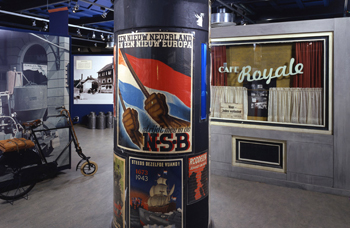
Just to the north of the Plantagebuurt lies the Oosterdok, whose network of artificial islands was dredged out of the River IJ to increase Amsterdam’s shipping facilities in the seventeenth century. By the 1980s, this mosaic of docks, jetties and islands had become something of a post-industrial eyesore, but since then an ambitious redevelopment programme has turned things around. Easily the most agreeable way of reaching the Oosterdok is via the footbridge at the north end of Plantage Kerklaan – and metres from the Verzetsmuseum – which leads onto Entrepotdok.
Over the footbridge at the end of Plantage Kerklaan lies one of the more interesting of the Oosterdok islands, a slender rectangle whose southern quayside, Entrepotdok, is lined by a long series of nineteenth-century gabled warehouses that were once part of the largest warehouse complex in continental Europe. Above the main entrance, each warehouse sports the name of a town or island; goods for onward transportation were stored in the appropriate warehouse until there were enough to fill a boat or barge. The warehouses have been converted into offices and apartments, a fate that must surely befall the buildings of the central East India Company compound, at the west end of Entrepotdok on Kadijksplein.
From Kadijksplein, it’s a brief walk over to the Nederlands Scheepvaartmuseum (Netherlands Maritime Museum), which occupies the old arsenal of the Dutch navy, a vast sandstone structure that is underpinned by no less than 18,000 wooden piles driven deep into the river bed at enormous expense in the 1650s. At the time of writing, the museum is closed for renovation, and is expected to re-open by the end of 2013. The full-scale replica of an East Indiaman, the Amsterdam, can still be visited though, and is moored near the NEMO centre, a short walk from the museum.
Strolling west from the Maritime Museum along the waterfront, you’ll soon spy the idiosyncratic hood-shaped structure that has been built to house the Amsterdam Centre for Architecture, ARCAM. It hosts architectural displays, sometimes of a theoretical nature and sometimes warning/informing the city of what is in the architectural pipeline. There are also public lectures and discussions hosted here.
Prins Hendrikkade
![]() 020/531 3233
020/531 3233
Tues–Sun 10am–5pm, plus Mon 10am–5pm during school hols and June–Aug
€12.50
Back outside the ARCAM building, the foreground is dominated by a massive elevated hood that rears up above the entrance to the IJ tunnel. A good part of this is occupied by the large and lavish NEMO centre, a (pre-teenage) kids’ attraction par excellence, with all sorts of interactive science and technological exhibits spread over six floors and set out under several broad themes.
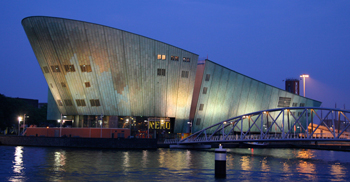
One of the Eastern dockland’s prime buildings, the Muziekgebouw is a brand-new, high-spec, multipurpose music auditorium overlooking the River IJ. It encompasses two medium-sized concert halls, a café and a bar. It also has state-of-the-art acoustics, and has given real impetus to the redevelopment going on along the IJ. As well as some contemporary music, it has a good programme of opera and orchestral music which brings a rather highbrow crowd to this part of town – and it’s worth a visit for the building alone.
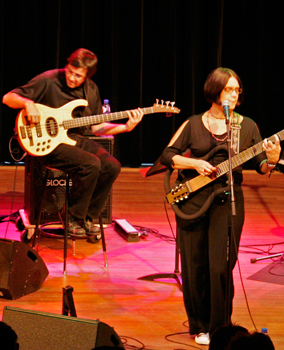
To the north and east of the Oosterdok, Zeeburg – basically the old docklands between the city library and KNSM Island – has become one of the city’s most up-and-coming districts. Actually a series of artificial islands and peninsulas connected by bridges, the docks here date back to the end of the nineteenth century. By the early 1990s, the area was virtually derelict so the city council began a massive renovation, which has been going on for the past fifteen years or so. As a result, this is the fastest-developing part of Amsterdam, with a mixture of renovated dockside structures and new landmark buildings that give it a modern (and very watery) feel that’s markedly different from the city centre – despite beginning just a ten-minute walk from Centraal Station. Explore the area by bike, especially as distances are, at least in Amsterdam terms, comparatively large – from the library to the east end of KNSM Island is about 4km.
Alternatively, there are two useful transport connections from Centraal Station: tram #26 to Sporenburg island via Piet Heinkade and bus #42 to Java Island and KNSM Island.
From the west end of Borneo island to the south of KNSM Island, C van Eesterenlaan slices south across a wide strip of water, the old Entrepothaven, bound for Zeeburgerkade, which is home to the Nederlands Persmuseum. The museum has a mildly interesting series of displays on the leading Dutch newspapermen of yesteryear, beginning with Abraham Casteleyn, who first published a combined business and political newssheet in the 1650s.
Of more immediate interest perhaps are the cartoons, often vitriolic attacks on those in power both in the Netherlands and elsewhere; for instance, the last premier – Jan Peter Balkenende – is often mockingly portrayed as Harry Potter (he looks like him).
Has an outstanding range of Dutch jenevers (gins) and flavoured spirits as well as a good selection of imported wines. Part of a popular chain.
One of the city’s best art bookshops, it stocks a raft of English-language titles and is good for photography too. Mostly new books, but some rare and antique ones as well.
Amsterdam’s own city beach situated on the IJsselmeer. The beach might be somewhat of a disappointment, but Blijburg is very much happening with DJs in summer and live music in winter. Last stop of tram #26 from Centraal Station.
Easy-going grand café, right next to the Muziektheater. Comfortable chairs, friendly service and a low-key, chic atmosphere. The kitchen is open all day, except for a brief break 5–6pm.
Plantage Middenlaan 2a
Mon–Fri 9am–4.30pm, Sat & Sun 10am–4.30pm; Dec & Jan closes 3.30pm; July & Aug until 8.30pm
The café in the orangery of the Hortus Botanicus serves tasty sandwiches and rolls plus the best blueberry cheesecake in the Western world. You do have to pay to get into the gardens to get to the café.

Tiny place which – contrary to what the homely interior with Delft blue crockery might suggest – has an excellent Indonesian inspired menu. Tasty saté, soto ajam and traditional Indonesian spekkoek (spiced cake) served with coffee.
Cosy if cramped café, with wooden tables and a big replica of Rembrandt’s Staalmeesters on the wall. Breakfast until 4.30pm for the genuine night crawler and a small selection of cocktails.
An uncomplicated fish restaurant serving an interesting selection of seafood, such as seabass with rosemary and thyme. Mains at around €23.
The Amsterdam branch of Jamie Oliver’s successful formula, annually giving a bunch of youngsters the chance to prove themselves in a top-notch restaurant. Also a less formal trattoria and lounge.
A cosy, busy restaurant that serves up Dutch staples with a modern twist. A changing menu reflects the seasons and the favourite dishes of the owner’s mother – a native of the southern Netherlands. Superb home-cooking in a great atmosphere.
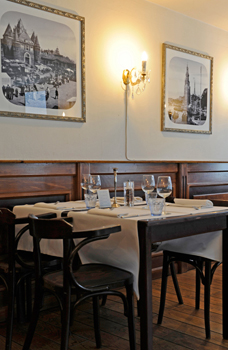
African restaurant in a largely forgotten part of town, serving West African antelope goulash, Moroccan tajine and crocodile steak. Vegetarian options available. Small, moderately priced and super-friendly.
Formerly a Communist Party café and apparently the place where the local dockworkers used to receive their wages, this is now an Oosterdok café-restaurant – try the sauerkraut.
This attractive trattoria occupies smart canal-side premises and serves excellent Italian food – especially the ravioli. Mains around €20.
De Gooyer Windmill, Funenkade 7
A 10min walk east of the Maritime Museum along Hoogte Kadijk
Daily 3–8pm
Cosy bar and mini-brewery adjacent to the De Gooyer windmill. Serves an excellent range of brews, including the thunderously strong Columbus.
Possibly the city’s oldest bar, and certainly one of its more beguiling, this neighbourhood joint pulls in an easy-going crowd.
This pleasant little bar occupies an old and now solitary gabled house that stands sentry by the lock gates opposite the Rembrandthuis. A smashing spot to nurse a beer on a warm summer’s night, gazing down the canal towards the Montelbaanstoren.
Oostelijke Handelskade 44
![]() 020/779 1575
020/779 1575
Tues–Thurs 11am–1am, Fri 11am–2am, Sat noon–3am, Sun noon–1am
Old-fashioned coffeehouse (not to be confused with coffeeshop) with wooden panelling and heavy red curtains, located in a 1917 state monument. Small but varied menu and live music in the backroom on Saturday and Sunday.
The city’s premier jazz and improvised music venue is located right next the Muziekgebouw, beside the River IJ to the east of Centraal Station. The Bimhuis showcases gigs from Dutch and international artists throughout the week, as well as jam sessions and workshops. There’s also a bar and restaurant for concert-goers with pleasant views over the river.
Located in a modern glass building overlooking the water, the Muziekgebouw showcases everything from classical through to jazz and rock, and has studios, rehearsal space and convention facilities.
Tucked away in an old warehouse, this underground venue hosts everything from jazz to pop, funk, punk and folk, with live gigs and DJs from Thursday to Sunday.
All-in-one restaurant, bar and nightclub located in the former power plant located right on the river IJ. Many live performances as well as internationally renowned DJs on weekends. One of the coolest spots in the city, Panama has played a leading role in spicing up the Eastern docks.
